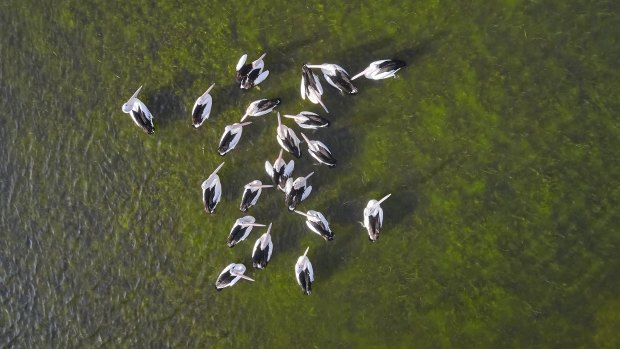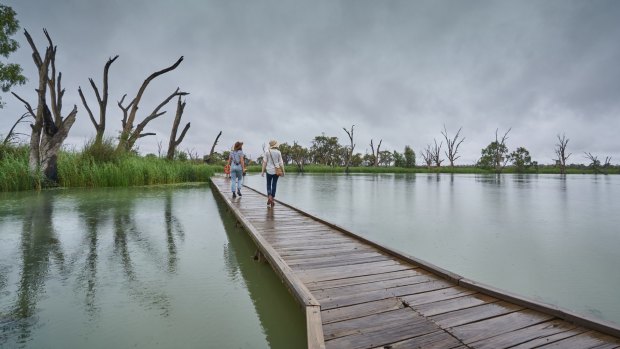This was published 2 years ago
Banrock Station winery and wetlands: A winery like no other
By Andrew Bain

Banrock Station is no ordinary cellar door, with water as much the focus as wine. Almost 200 bird species – around one-quarter of Australia's total species – have been sighted on the property.
Inside a bird hide on the banks of the Murray River, Tim Field scans the surface of a wetland. A cormorant is perched atop a flooded log, its wings held out like drying washing, and hordes of ibis nest on reedy islands. A blue-billed duck sails past, a rare sighting even for Field, who has spent a decade working at this site in South Australia's Riverland region. It's a good day in the wetlands.
"To borrow a wine phrase, spring is our vintage," he says. "That's when we need to be out here looking at everything and seeing how it's all going."
The wine analogy is a fitting one, for this wetland, cradled inside a bend in Australia's longest river, is pooled across a winery. Across the water, a low ridge is covered in vines and the rammed-earth cellar door for Banrock Station, one of the largest wineries in the Riverland, a region that produces more than 30 per cent of Australia's national crush – by production, it's the largest wine region in the country.

The boardwalk is the most popular of Banrock Station's walks, providing a glimpse into the wetland's vitality.
But Banrock Station is no ordinary cellar door, with water as much the focus as wine. The deck of the cellar-door-cum-restaurant, known as the Wine and Wetland Centre, seems almost to hang over the wetland. Black swans sail along the shores, and the sky is an air show of birdlife as pelicans and ibis turn on the thermals.
Around one in three visitors to the Wine and Wetland Centre go beyond the tasting notes, striding out on one of the walking trails through the wetland, which form a green spot in a monochromatic landscape. It's a far cry from the scene here 30 years ago.
For more than a century, the wetland was part of a sheep property, grazed and trampled by stock. In 1995 the property was purchased by BRL Hardy (now Accolade Wines). The land was destocked, grapes were planted, and a plan to rehabilitate and return the wetland to a more natural cycle of wet and dry periods was created. In 2002, it was the first privately owned site in Australia to be named as a wetland of international importance by Ramsar.
Today, Banrock Station employs three full-time rangers to look after the wetland, with a portion of every wine sale going towards its management. Almost 200 bird species – around one-quarter of Australia's total species – have been sighted on the property.
"We are one of the 10 most diverse bird sites in South Australia," says Field, Banrock Station's wetland manager, as we wander along the boardwalk that crosses the wetland.
The boardwalk is the most popular of Banrock Station's walks, providing a glimpse into the wetland's vitality. As we walk, reed warblers call from among the reed beds, and the shallowness of the water – around one metre on average – means that the boardwalk has no railings, seeming to draw everything in this wetland world closer.
This day, water levels are high, but this isn't always the case. In regulating the natural cycle of wet and dry, Banrock Station typically fills and drains the wetland in three-year cycles. This summer, it has been drained, with the winery adding to its suite of trails by adding dry- bed walks that provide a glimpse at what lurks beneath – the likes of animal trails, yabby holes, emerging red gum seedlings and burrowing frogs.
"There are so many stories you can tell," Field says.
The longest of Banrock Station's walks is a full lap of the wetland, an eight-kilometre circuit, past five bird hides, that's listed as one of South Australia's 40 Great Short Walks. Visitors can grab a bag of picnic goodies, a bottle of wine and a rug from the Wine and Wetland Centre, with a couple of dedicated picnic sites along the trail.
"I always suggest to people that they walk around the eastern side first," Field says. "That's through open, salt-affected country. Then they get here to the boardwalk and it's a real 'wow' moment."
The wetland walks have long been the mainstay of Banrock Station's visitor experience, but as the revitalisation of the wetland continues and develops, so too does the winery's tourism vision.
Guided birdwatching tours have been introduced, along with combined wetland and wine-tasting tours, with plans to bring the region's defining feature – the Murray River – into visitor view through experiences such as river cruises on the Loch Luna.
The sliver of land separating Banrock Station's wetland from the Murray is, at its narrowest, less than 100 metres wide, making the river a natural companion. In Kingston-on-Murray, just a couple of kilometres upstream from Banrock Station, I board the Loch Luna, and soon we're drifting past the wetland towards Overland Corner, where Lock 3 was installed across the Murray in the 1920s to divert water to surrounding farms. The river is as brown as a gravel road, and it flows listlessly – we are 437 kilometres from its mouth, but just 10 metres above sea level.
On the three-hour cruise with Loch Luna's owner Carl Doubikin, who also leads Banrock Station's birdwatching tours, we will circuit Snake Island, first along the Murray River and then through the narrow back creeks that flow like a moat around its edges.
At Overland Corner, we turn into Loch Luna, a once-dry creek bed that flooded when the lock was built, raising the river level by three metres. Dunes pour down the riverbank, scarred Aboriginal canoe trees stand along the island's shores, and the water is suddenly crowded with birds – swans, cormorants and masses of pelicans congregating on logs.
"The Murray is a beautiful waterway," Doubikin says. "They say its water gets into your blood."
The expansion of Banrock's visitor experiences will also extend across the land. Almost one-third of the property remains covered in mallee, black box and river red gum woodland. At the back of the property, beyond another sharp bend in the river, is a floodplain that, until recently, hadn't seen water for 30 years.
In 2015, Banrock Station began to channel water back into these plains. Driving around it now with Field, there's a safari-like feeling to the country that has it primed to become a new piece of the Banrock experience. Kangaroos bounce about, dunes add shape to the land, the Murray trudges past and, where water has been, it's as if the land has been airbrushed in bright, clean colours.
"Before 2015, this was a dead landscape," Field says. "Now it's recovering through what we're doing."
THE DETAILS
VISIT
Banrock Station is a 2.5-hour drive north-east of Adelaide via the Barossa Valley. The Wine and Wetland Centre is open daily. See banrockstation.com.au
STAY
Green and Gold House Boats has a range of houseboats in Waikerie, ranging from one to six bedrooms. See greenandgoldhouseboats.com.au
Andrew Bain travelled courtesy of Banrock Station.
MORE
traveller.com.au/south-australia
FIVE OTHER WETLAND EXPERIENCES
YELLOW WATER, NT
Float past crocodiles, buffalo, magpie geese and jabirus on a sunrise or sunset cruise in the wetlands of Kakadu National Park.
COORONG NATIONAL PARK, SA
Cruise through the waters and birdlife of the Coorong and the mouth of the Murray River on the Spirit of the Coorong.
BARMAH FOREST, VIC
Australia's largest continuous stand of river red gums and the 'Barmah Choke', where the Murray River narrows, is the focus of trips with Kingfisher Cruises.
NOOSA EVERGLADES, QLD
Kayak up the Noosa River, one of the planet's two everglade systems, paddling through mirror-like river reflections.
TROPICAL WETLANDS SHARED EARTH RESERVE, QLD
Binoculars to the fore on an Australian Wildlife Journeys' birdwatching trip to the lakes and swamps of this private reserve, where more than 450 bird species have been recorded.
Sign up for the Traveller Deals newsletter
Get exclusive travel deals delivered straight to your inbox. Sign up now.